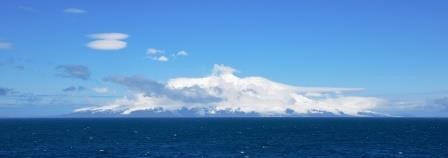Position 53°06′S 73°32′E
After the Crozet Island we head towards Kerguelen. This time we are unlucky, the weather is stormy and rainy. There is no point in flying the helicopters and going ashore with the zodiacs is not without risk. So operations around the island are short. We do what we can and then leave to go to Heard Island.
Heard is a volcanic island that is rarely visited. Visiting rules are so strict that we did not get permission. However, we can pass by and continue our atmospheric measurements on the ship. Marine operations need to stop while we are going through the marine protected area around the island. It’s a three-day voyage from Kerguelen and we do not have great hopes of seeing anything after the recent weather experience and knowing that Heard Island is in clouds 350 days a year.
But this time we are lucky. The sea is calm, the sun is shining. We cut breakfast short and wait on deck with our cameras. We are unbelievably lucky, we can see the island though still with clouds, some very nice lenticularis clouds, by the way. We can see the dark lava and the white glaciers. There’s a small island in front of Heard, which was “born” only last year due to the vulcanism. This is fascinating. The ship has to move very slowly, because the marine charts are not up to date anymore after the new island was born and we don’t want to hit ground. This leaves us enough time to see how the clouds are evaporating and the peak appears. The island is 2745 m high. Only five parties were allowed to climb it, but not all were successful. While we listen to the history of the island told by our Australian colleagues, we start to wonder why there is a little cloud at the summit that does not evaporate but remains steady. Looking through the binoculars we realize it’s not a cloud but fumes from the active volcano.
While we remain on deck, fascinated by the precious environment, our instruments keep measuring. And believe it or not, we experience the cleanest air mass during the expedition so far: 60 particles per cubic centimeter. This turned out to be a perfect day.
A couple of days later, we give our science talk on the project: In search of the pristine atmosphere. Given the recent experience that stuck with everyone, it’s an easy job to explain what we are investigating and why.
